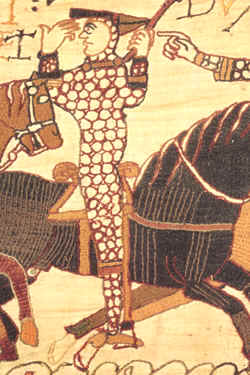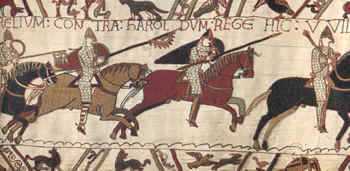William the Conqueror should strictly be known as William I. William is credited with kick-starting England into the phase known as Medieval England; William was the victor at the Battle of Hastings; he introduced modern castle building techniques into Medieval England and by his death in 1087, he had financially tied down many people with the Domesday Book.
|
|
William was born in 1027 and he died in 1087.
His father was Robert, Duke of Normandy and his mother was Herleve of Falaise. They never married and William was known as “William the Bastard” to his enemies – though this was never said to his face when he had grown up.
In 1035, Robert died and as his only surviving heir, William became Duke of Normandy at the age of 8. William’s young age and the fact that he was born out of marriage, meant that many lords in Normandy did not approve of him ruling them. In 1040, they tried to kill William. The plan failed but William’s guardian – Gilbert of Brionne – was killed.
In 1047, the lords in western Normandy rebelled against William again. They, again, failed but these two incidents taught William to trust no-one. He also became a victim of the violent time he lived in. He believed that if someone betrayed him, then he should show no mercy. If a village or town betrayed him, then he should show no mercy. In 1051, citizens in the town of Alençon, which William was besieging, taunted him about being illegitimate. Once the town had fallen to him, he ordered that those who had abused him should have their hands and feet cut off.
In 1051, William met Edward the Confessor. William claimed that at this meeting, Edward promised him the throne of England on Edward’s death. However, there were no proper witnesses to this meeting – only those who wanted to keep on the good side of William.
In 1053, William married Matilda of Flanders. They had nine children, of whom seven survived.
During the next ten years, William had to constantly fight off invaders to his territory. He was always successful and built up a feared and professional army. His army’s main power was based on his cavalry – horse borne soldiers. These men were highly trained. They wore chain mail into battle, used a lance, sword or mace to fight with and rode horses that were bred to carry such a weight at speed.
|
William’s cavalry as shown in the Bayeaux Tapestry |
After defeating Harold at the Battle of Hastings, William gained control over England by the use of the Feudal System. His control over the people was greatly extended by the Domesday Book.
He died in September 1087 after suffering from major internal injuries when his horse, scared by embers in a burning Norman village, reared and rammed the pommel on the saddle into William’s stomach. He took several days to die. When he did, he was buried but he was too big for his coffin and his body had to be stuffed into it. Legend has it, that the body split open because it had rotted so much before burial……………What was put into his coffin was stolen in 1562 – all except a thigh bone. This was removed during the French Revolution – no-one knows the whereabouts of the skeleton of the man who won the Battle of Hastings!
| “Assuredly in his time, men suffered grievous oppression and manifold injuries. He caused castles to be built which were a sore burden to the poor.” Anglo-Saxon Chronicle on William |
See also The Laws of William the Conqueror
William the Conqueror and Consolidation of Power 1066-1087
Related Posts
- William III became king of Great Britain after the 1688 Revolution. William, along with his wife Mary II, was crowned on February 13th 1689 after…


